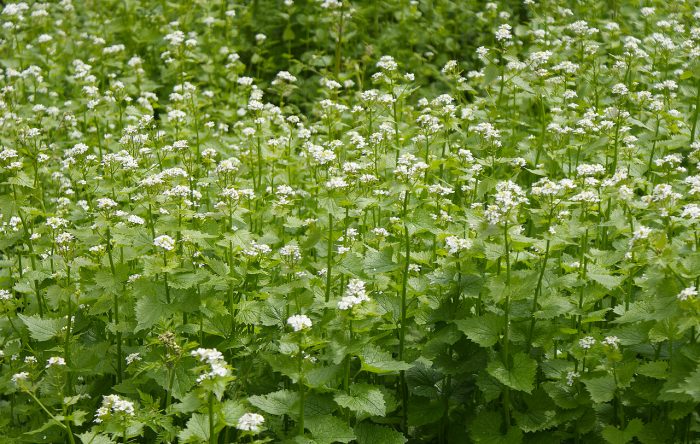 In the Spring I published an article about how to learn fifty wild plants in just ten minutes (all the wild UK members of The Mint Family). To continue on a similar theme, this month I have chosen another huge group of plants, many of which are part of our conventional food chain and plenty of which are tasty and nutritious wild edibles, mustards, cress’s, rockets, kales etc. By the way, I haven’t always been such a massive nerd….if you’d asked me a few years ago what my opinion of wild cabbages was, I would have stared blankly or waited until a suitably sarcastic comment emerged. What started with me foraging for wild mushrooms as a way of avoiding work, fifteen or so years ago, now brings me to here, to write about the joys of hunting for wild Water Cress and other members of this amazing group of plants. If you didn’t read the other blog I suggest you take a 2-3 minutes look at the first section which will introduce some useful ideas on how to forage and how to behave when dealing with different plant families, depending chiefly on the number of poisonous and edible plants they contain. Here’s a link
In the Spring I published an article about how to learn fifty wild plants in just ten minutes (all the wild UK members of The Mint Family). To continue on a similar theme, this month I have chosen another huge group of plants, many of which are part of our conventional food chain and plenty of which are tasty and nutritious wild edibles, mustards, cress’s, rockets, kales etc. By the way, I haven’t always been such a massive nerd….if you’d asked me a few years ago what my opinion of wild cabbages was, I would have stared blankly or waited until a suitably sarcastic comment emerged. What started with me foraging for wild mushrooms as a way of avoiding work, fifteen or so years ago, now brings me to here, to write about the joys of hunting for wild Water Cress and other members of this amazing group of plants. If you didn’t read the other blog I suggest you take a 2-3 minutes look at the first section which will introduce some useful ideas on how to forage and how to behave when dealing with different plant families, depending chiefly on the number of poisonous and edible plants they contain. Here’s a link
https://www.foragelondon.co.uk/foraging-is-easy-learn-50-plants-in-just-10-minutes
Fortunately, The Cabbage Family, or to give it its “proper” name Brassicaceae, contains no poisonous members (at least not in the UK), so our safety depends on making sure we are in the right family rather than making specifically sure we have the right species…this is also necessary but not, as with some other plant families, likely to lead to a nasty death if we confuse one cabbage for another. There are a few members of this group that taste pretty horrid and I’m sure would result in a nasty stomach ache if eaten in bulk, but that is about as far as it goes. Learn how to ID this group and you have another 100 plants to add to your repertoire ( is a repertoire of cabbages actually possible?).
So, if we imagine this huge group of plants (about 3700 species world wide and nearly a hundred wild varieties in the UK) plotted on a straight line from left to right, at one end we have the blander domestic varieties, White Cabbage, Broccoli, Cauliflower etc. Move along the line a bit and we get more flavour, Kale, Red and Purple Cabbages, then Rocket and some of the more tasty salad leaves, further still we get numerous types of Cress and Water Cress, then the Mustards and Radishes and right on the end, Horse Radish. This line has little to no botanical merit but I find it an easy way to imagine the whole group, based primarily on their intensity of flavour. Some of the plants in this family can be too robust and/or too bitter to use for much, many have other uses such as oil production (Rape seed etc) but almost all of them, if visited by us at the right time, will produce something tasty and useable. The key, as with all foraging, is to go to the plant at the appropriate time of year and not try it just once and assume it was too bitter or too tough. A great example of this is Sea Radish, a big bristly monster of a plant that loves growing in harsh coastal environments. Try its large, coarse leaves in summer and you will not have much fun…however, cut away the leaves and just steam the leaf midrib and you have a succulent and sweet vegetable. Pick its yellow flowers and they give a lovely peppery zing to a wild salad. Better still, grab a handful of its pointy seed pods and enjoy more flavour and better texture than a good cultivated radish. More than just seasonal, these foods are very time specific, a week or two one way or the other and it’s easy to miss out on a terrific wild harvest. Assuming that you have read my two top ID tips in the previous blog, we can now get on with the business of how to ID this family and avoid any others in the process. I flippantly describe this as learning 100 plants in a few minutes but that’s really just the bones of it, and in fact, to do this properly, stay safe and get the most out of it, it takes many visits to the same places and same plants, to build up an intrinsic familiarity with them and to learn how they change and develop with the seasons and from year to year. This will, however, get you started.
1. SMELL. Any school kid can tell you the smell of overcooked cabbage, or they could when I went to school. Unlike this culinary travesty, most members of this family have a fresh, slightly fruity, often peppery smell to them. Get some Water Cress from the shop and give it a good squash and a sniff. This is the “smell spectrum” we are dealing with…a boring old white cabbage will have a quite pleasant, much milder smell if you crush some of its uncooked leaves, but smells are much easier to remember than they are to write about, so, use your nose and you will find it easy to log the most common aromas of this family. To forage effectively, we need to learn how to smell plants properly, sometimes the smell we are looking for in the colder months will be only fleeting and faint, more a memory of its strong summer scent, so the best approach is to take a good amount of the leaves or flowers (whatever is available) fold them over two or three times into a tight little bundle and then give it a good, hard twist to release any essential oils that the plant has. Smell is an excellent ID tool but needs to be used in conjunction with some more specific methods.
2. FLOWERS. Normally I’d leave talking about these until later on; ID from flowers is a real luxury for foragers and often happens at a time when the plant in question is well past its best. My previous blog covers the basics of what I call “leaning plants backwards” when all the best ID features are on show, then returning to them numerous times to compound that knowledge. The reason I list flowers as my second ID feature is that this blog primarily focuses on London or at least urban environments, basically micro climates where many of the rules either don’t apply or have changed to suit their surroundings. As a result, I often find specimens of a plant in flower very early on in the year, along side others that are behaving more normally and just putting up early greenery. Another, older name for this family is The Crucifers, taken from the arrangement of the flower’s petals…always four of matching size and shape and always arranged in a cross (well an X or an H really). This, coupled with the smell, is very often the only information we need to ID members of this group…does is smell cabbagy? Does it have four petals arranged in a cross ( almost always yellow or white, occasionally mauve like the Cuckoo Flower above) ? Very likely we are in the right place. Grab a good flower key, skip to the right section and try to make a visual ID. If you want to get a bit botanical and have either good eye sight or a hand lens, you could also count the amount of Stamen…always 6 of them (4 tall and 2 shorter) in a 4 petalled flower and you are definitely in the right family.
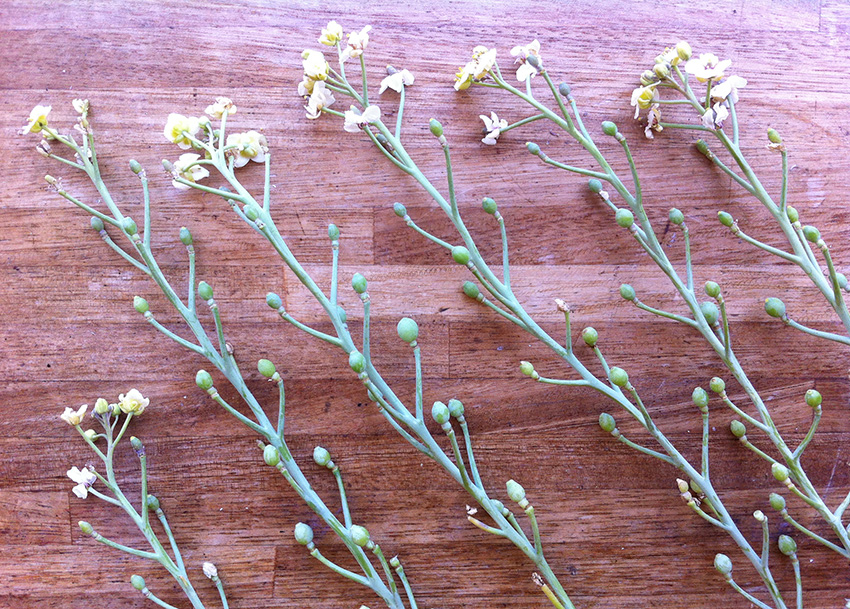
3. SEEDS AND PODS. Thomas Elpel, the author of the excellent Botany in a Day, describes the arrangement of seeds in this family as being like a spiral staircase for tiny people. Although the shape of the seeds varies enormously, some round, some heart shaped, many long and thin, they almost all occur in a spiral formation around the upper stem of the plant (as in the illustration below). Very often there will be the previous years dead growth sticking up out of the young base leaves of the new growth, if not then in close proximity and this is where to view the seed arrangement early on in the year and an excellent way to further confirm that we are in the right place.
4. LEAF GROWTH AND SHAPES. This is where it gets a little harder for the total novice and actually much easier for anyone with a little (easily acquired) experience. In many cases the three methods above are all we need to ID our way to some tasty wild food, however, in order to get our hands on the delicious young growth from this group of plants, we need to become familiar with their leaves, or more specifically, the shape of the “Basal Rosette” they form, close to the ground…basically a ring of low growing leaves centred around a single point, like a target. The best illustration of this is probably a Dandelion, which grows in exactly this way and then puts up a single flower stem with a single yellow flower on top. The Dandelion is actually a member of The Daisy Family (Asteraceae) but both the daisies and the cabbages grow in this way. In addition, both families produce plants with a vast array of leaf shapes; these take a little time to get to know but once we know a few, most of the others just drop into place. It’s invaluable to see these plants in all stages of their growth, the simple leaf shapes of the young plant often having little to no resemblance to the more complicated mature ones.
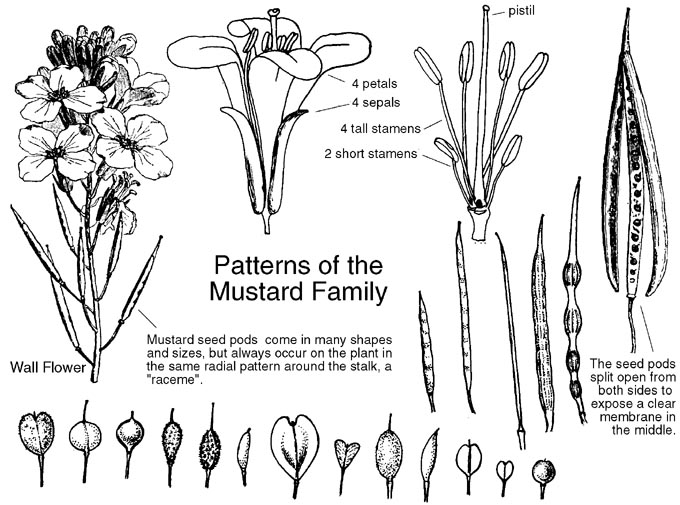 “Illustration used with permission of Thomas J. Elpel, author of Botany in a Day.”
“Illustration used with permission of Thomas J. Elpel, author of Botany in a Day.”
5. OTHER IMPORTANT THINGS. Habitat and season will often help with the more specific parts of the ID. Is this huge cabbage sitting on a shingle beach? Then probably it’s Sea Kale or Sea Rocket. Or is it clinging to the base of a cliff ? More likely it’s a Wild Cabbage instead. Does this tall plant with yellow flowers appear near a huge field of Rape? Chances are that’s exactly what it is. Is this Cress like plant growing in the water..you guessed it, Water Cress. On the topic of plants growing in fresh water, please NEVER eat anything from the waters edge or from in the water unless you cook it. Liver fluke is a dangerous parasite that can do us serious damage… find out more about sensible foraging.
The other most important part of this process is to avoid “wandering” into another, potentially dangerous plant family. As I mentioned above, The Daisy Family very often has similar young growth and there is a small section of this group, The Ragworts, that should be avoided… a stomach ache, not a trip to hospital, is more than likely the outcome of any error, but none the less it pays to get a good wild flower key (I use Francis Rose’s fantastic book) and have a look at these 8 plants. If ever you have the slightest doubt, don’t eat it! Although a nibble of one of these leaves will do no harm and will quickly tell you it’s not cabbagy, I do not advocate tasting things as part of the ID process, this approach, especially with some of the more dangerous plant families, can lead to serious illness. A few other plant families have vaguely similar flowers with four equal sized petals, The Poppies, Bedstraws, Willow Herbs, Buddleias and Olives but none of these bare any resemblance to The Cabbages and pose very little threat to our health anyway. So, off we go, to the fields, the seashore, the meadows and lanes. It’s Summer Time now so expect strong flavours and robust textures, all the best ID info will be on show and all the information we need for many successful forays. Happy hunting.
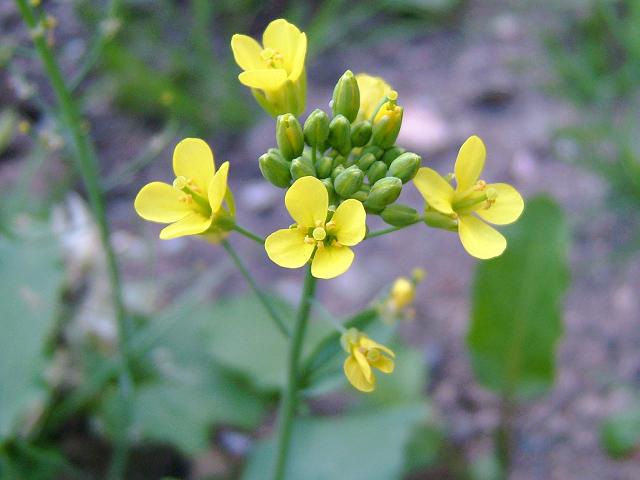
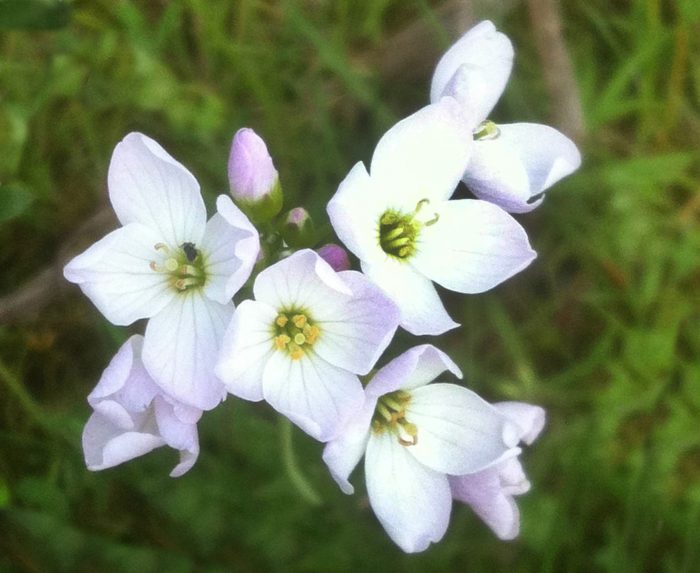

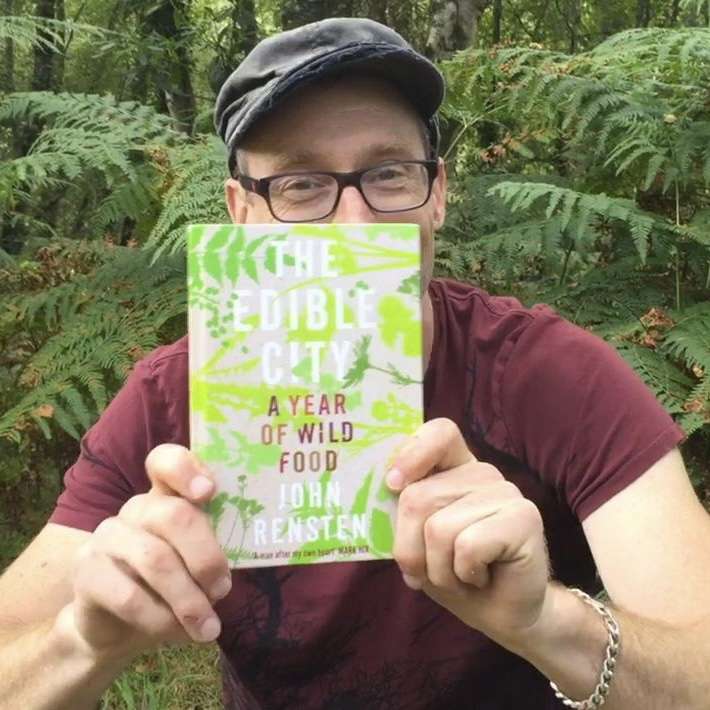
Very handy and useful to give some general guidelines and rules about what’s safe than bamboozle people by trying to teach them individual plants
Thanks Gemma, the simplest approach is always the best, for me at least
John thank you for this simple aproach I read both articles 50 and 100 edibles in 10 minutes and also some information by Thomas J. Elpel, but i was wondering… Can you eat them raw or do you need to bake or Boil them. And what parts of these plants can we use (root, stalk, leaves, flowers and/or seeds)?
Bugle is edible isn’t it as I’ve had the young shoots and young leaves and people use then for caserol or teas
I didn’t know it was a poisonous plant can you please verify this
Thanks
Blue x
Hi Blue, yes it is edible but in large quantities is considered to be narcotic. I’m sure youre not in any risk, apologies if my blog was misleading.
Thank you John
No worries I was curious as I’ve had bugle few times but as always learn from you every time I watch or read your posts so thank you keep the excellent knowledge you have going
Blue x
Great post. I simply love wilted mustard greens as a side. Perfect for Pork, Chicken and Fish!